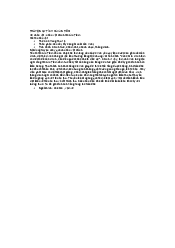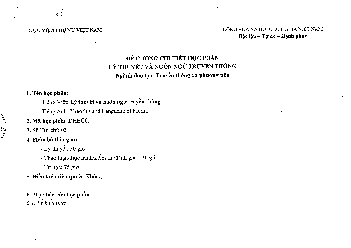







Preview text:
TỔNG HỢP LÝ THUYẾT CCO201 Câu 1: Wal-Mart
*Lập kế hoạch chiến dịch truyền thông
1. Strategic intent (Ý đồ chiến lược)
2. Define communication objectives (Xác định mục tiêu truyền thông)
3. Identify and prioritize target audiences (Xác định và ưu tiên đối tượng mục tiêu)
4. Identify themed messages (Xác định thông điệp chủ đề)
5. Develop message styles (Phát triển phong cách thông điệp)
6. Develop a media strategy (Phát triển chiến dịch truyền thông)
7. Prepare the budget (Chuẩn bị ngân sách) *Message Styles
Functional Orientation: Đề cập khả năng hoặc tài nguyên hữu hình, cụ thể của tổ chức
- Rational message style (Thông điệp hướng tới sự hợp lý)
Symbolic Orientation: Thu hút nhu cầu tâm lý xã hội, sở thích và kinh nghiệm của Stakeholders
- Symbolic association message style (Thông điệp liên hết biểu tượng)
- Emotional message style (Thông điệp nhằm vào cảm xúc)
Industry Orientation: Hướng tới đạt được mục đích cạnh tranh
- Generic message style (Thông điệp chung chung)
- Pre-emptive message style (Thông điệp mang tính phủ đầu)
Câu 2: WHO WILL YOU WANT TO BE?
* 8 chuyên ngành truyền thông doanh nghiệp (Chap 2)
- Advertising communication (Truyền thông quảng cáo)
- Marketing Communications (Truyền thông tiếp thị)
- brand communication (Truyền thông thương hiệu)
- Public Relation (QHCC)
- Communication management (truyền thông quản trị )
- Internal communication (truyền thông nội bộ )
- Truyền thông tuyển dụng
- Truyền thông văn hóa
*11 chuyên ngành truyền thông doanh nghiệp khi có PR & Marketing - Public affair
- Issues management
- Investor relations
- Media relations - Advertising
- Direct marketing
- Sales promotions
- Digital/Online communication
- Internal communication
- Community relations
- Publicity/Sponsorship
Câu 3 (FACEBOOK) + Câu 4 (TH True Milk) - CHƯƠNG 6 - Mô hình SMART:
- Specific: cụ thể
- Measurable: đo đếm được
- Attainable: có thể đạt được
- Relevant: có liên quan -
Time: trong thời gian cố định - 7 bước lập kế
hoạch chiến dịch:
- Strategic intent (Ý đồ chiến lược) = vision + reputation
- Define communication objectives (Xác định mục tiêu truyền thông)
- Identify and prioritize target audiences (Xác định và ưu tiên đối tượng mục tiêu)
- Identify themed messages (Xác định thông điệp chủ đề)
- Develop message styles (Phát triển phong cách thông điệp)
- Develop a media strategy (Phát triển chiến dịch truyền thông)
- Prepare the budget (Chuẩn bị ngân sách)
- Hệ thống truyền thông 3M: (chương 3)
- Owned Media: organization owns and controls the media
- Paid Media: organization pay to be on other media platforms
- Earned Media: organization have stories interesting enough for other media
platforms to write/post about them
Câu 5 - CHƯƠNG 8: MEDIA RELATIONS
- 5 công cụ: (chương 8 )
+ Press releases: transfer news to journalist for publishing
- Design a preferred setting for the news (expectation, frames, deadlines)
- Choose preferred types of journalist
- Print journalist: publish news and information in a pyramid scheme
- Radio journalist: faster information and news - Choose preferred types of reporter:
- Business reporter: cares about business audience
- Public affair reporter: concern about public
+ Press conferences: to release result and share corporate information, to release new product
or discuss about issues or crisis => to create conversations between journalists and the corporate
+ Interviews: an official spokesperson answering questions from journalists in an interview
- communication practitioners must guide the spokesperson about what to say
+ Online newsrooms: a website designed by the corporate to connect with different platforms
and media => provide journalists with information + Media monitoring and research: do
research about the media - techniques: - gate-keep research: - output analytics:
- media monitoring services:
Câu 6 + 7+ 8 + 10 (KHỦNG HOẢNG + STAKEHOLDER) + 11 - CHƯƠNG 11:
COMMUNICATION IN CRISIS 1. What is the crisis?
A crisis is defined as an event or issue that requires decisive and immediate action from an
organisation. The necessity of immediate action may be triggered by public pressures, media
attention or the direct danger to employees, customers or members of the general public. Crises
may involve accidents or natural disasters, but may also stem from actions and failures within the organization.
2. Crisis-type matrix (Mô hình Matrix của Timothy Coombs): phân loại khủng hoảng
Crisis expert Timothy Coombs defines four types of crises based on two dimensions: internal–
external and intentional–unintentional, specifically:
A faux pas (Giả mạo) is an unintentional action which is transformed into a crisis by an
external actor. A faux pas often begins as an issue between an organisation and a particular
external actor who challenges the appropriateness of the organisation’s actions. When an
organisation does not engage in debate with this actor or when public opinion and stakeholder
expectations move against the organisation, the issue may turn into a crisis.
Accidents (Tai nạn) are unintentional and happen during the course of normal organisational
operations. Product defects, employee injuries and natural disasters are all examples of
accidents. The unintentional and generally random nature of accidents often leads to
attributions of minimal organisational responsibility, unless of course the organisation was
directly responsible for the accident. Accidents can be further divided into acts of nature (e.g.
hurricanes, earthquakes, epidemics) and human-induced errors (e.g. industrial accidents).
Transgressions (Vi phạm) are intentional acts taken by an organisation that knowingly place
stakeholders or publics at risk or harm. Knowingly selling defective or dangerous products,
withholding safety information from authorities, violating laws, or ‘creative’ bookkeeping are
all examples of transgressions.
Terrorism (Khủng bố) refers to intentional acts taken by external agents. These intentional
actions are designed to harm the organisation directly (e.g. hurt customers through product
tampering) or indirectly (e.g. reduce sales or disrupt production). Product tampering, hostage
taking, sabotage and workplace violence are all examples of terrorism.
3. 5 levels of contingency plans:
Organizations can develop crisis contingency plans by 5 stages:
Các tổ chức có thể phát triển kế hoạch dự phòng khủng hoảng theo 5 giai đoạn sau:
1. Minimal planning around a few contingency plans drawn up for an emergency response,
such as evacuating a building during fire or giving first aid to employees who suffer
injury or sudden illness. Lập kế hoạch tối thiểu xung quanh một vài phương án dự phòng
được lập ra để ứng phó khẩn cấp, chẳng hạn như sơ tán khỏi tòa nhà trong khi hỏa hoạn
hoặc sơ cứu cho những nhân viên bị thương hoặc bị bệnh đột ngột.
2. More extensive planning but is limited to natural disasters and potential human errors,
involves measures for damage containment and business recovery.
Lập kế hoạch sâu rộng hơn nhưng chỉ giới hạn ở thiên tai và các lỗi tiềm ẩn của con
người , liên quan đến các biện pháp ngăn chặn thiệt hại và phục hồi kinh doanh.
3. Extensive contingency plans which include crisis procedures for probable natural
disasters and human errors and the training of personnel so that employees can
implement these crisis procedures Kế hoạch dự phòng mở rộng bao gồm các quy trình
khủng hoảng do thiên tai và lỗi của con người có thể xảy ra và đào tạo nhân sự để có
thể thực hiện các quy trình này
4. An organization-wide consultation of potential crises and their impact on stakeholders.
The scope is wider, includes products defects, tampering and social issues regarding the company
Tham vấn toàn tổ chức về các cuộc khủng hoảng tiềm năng và tác động của chúng.
Phạm vi rộng hơn, bao gồm lỗi sản phẩm, giả mạo và các vấn đề xã hội liên quan
5. Involves all of the previous stages but also incorporates environmental scanning and
early warning systems to identify crises
Liên quan đến tất cả các giai đoạn trước nhưng kết hợp các hệ thống cảnh báo sớm
và quét môi trường để xác định khủng hoảng càng sớm càng tốt.
*6 cách giải quyết khủng hoảng trong slide chương 11
4. Consequence (Hậu quả của khủng hoảng)
A crisis may also damage the image or reputation of the organisation more generally, which
may also lead to a loss of earnings in the long run. If, as a result of the crisis, the company’s
reputation shifts from favourable to unfavourable, stakeholders are likely to change how they
interact with an organisation. Customers may walk away or boycott a firm and investors may decide to invest elsewhere.
5. The impact of a crisis on corporate reputation
● A crisis may disrupts an organization’s operations and poses both a financial and a reputational threat.
Khủng hoảng có thể làm gián đoạn hoạt động của tổ chức, đe dọa cả về tài chính và uy tín
● A crisis may also damage the image or reputation of the organization Khủng hoảng làm
hỏng hình ảnh hoặc danh tiếng của tổ chức
● Customers may walk away or boycott the firm, investors may decide to invest elsewhere.
Khách hàng có thể bỏ đi hoặc tẩy chay công ty, nhà đầu tư có thể đầu tư vào nơi khác
● When the organization mishandles communication following the crisis, it may potentially
lead to stakeholders severing their ties with the organization or spreading negative word-of-
mouth about the company Truyền thông sau khủng hoảng, nếu sai, có khả năng dẫn đến việc
các bên liên quan cắt đứt mối quan hệ với tổ chức hoặc truyền miệng tiêu cực về công ty. Câu
9: Vodafone: Using Employee Communication to Empower Employees CICS: -
Broader focus than manager–employee dyad -
Involve technologies and communication systems -
Broadcast corporate decisions and development to employees across the organization -
Disseminating information about the organization to employees in all ranks and functions -
Preserve of communication Dept, who are charged with releasing information
to employees through: intranet, emails, ‘town hall’ meetings Downward communication -
Information from top to bottom -
Focus on missions and policies -
Management com + CICS = downward communication Upward communication -
Information from employee to managers
Câu 10: Chương 4 + 11
Định nghĩa Stakeholders: Any group or individual who can affect or is affected by the
achievement of the organization’s purpose and objectives
Power-interest model: 4 types of stakeholders
- A: Minimal effort: low power + low interest => DN ko quan tâm
- B: Keep informed: low power + high interest => DN vẫn cung cấp thông tin cần thiết
- C: Keep satisfied: high power + low interest (vd nhà đầu tư, báo chí,...) => DN cần
làm hài lòng, giữ cho nó quan tâm đến DN nhiều nhất có thể
- D: Key players: high power + high interest => core stakeholder, DN cần show tất cả thông tin + làm hài lòng Stakeholders: - customers D - employees - investors - suppliers C - governments B/C - political groups - communities - trade associations - distributors D - shareholders - lenders - media B - consumers - regulators - competitors A

